Vantage
IMS Vantage is a visualisation-and-analysis toolkit used to explore and understand seismicity, both spatially and temporally within a 3D volume of rock, such as a mine. Its intuitive user interface allows users to get started quickly, while simultaneously enabling them to delve deeper when necessary. It allows for close integration with the rest of the IMS seismic system, including IMS Trace and the IMS database server.
The level of complexity of the user interface in IMS Vantage can be customised, allowing users to start with a simplified, reduced set of features, and incrementally add more as they become accustomed to the software.

FEATURES
- seamless integration with the IMS seismic system, including seismic databases via the IMS database server
- rich set of visualisation options, including contours, isosurfaces and hyperstreamlines
- time histories of seismicity, together with other user data, such as blasting/production
- grouping of events spatially, by time or by using event parameters
- advanced cluster analysis of seismicity
- exporting of analysis results to standard spreadsheets for further manipulation
- animation of seismicity, together with mine plans, contours and isosurfaces
- all analyses are quantified with the relevant statistics
- unprecedented integration ability for users who also have IMS Trace or the IMS database server. In particular, users who have the IMS database server, exposing their database to their local network, need not use classical EVP files to update their event sets, but do so directly over an HTTP connection.
FULL 3D VISUALISATION
The IMS Vantage 3D view allows for direct access to objects in the 3D scene, and to query or manipulate these objects.
Seismicity, modelled stresses and/or other data can be visualised as points, vectors, contours and isosurfaces. Visualisation combined with full 3D navigation and interaction provides a holistic view of what is happening on the mine. Types of interactions:
- rotate, zoom and pan the scene using the mouse or keyboard
- click on a seismic event to obtain its parameters
- click on a seismic event to access its waveforms (in case of combined Vantage and Trace installation)
- click on an object in 3D format to acquire its location and data value.
MINE PLANS AND PRODUCTION DATA
The wireframes or string lines of mine plans can be brought to Vantage. Several formats can be used: DXF, Surpac, DGN and ASCII. The wireframes of geological structures are also very helpful for the analysis and interpretation of recorded seismic data.
The information about stope and development firings, bogging/mucking can also be imported in Vantage and used in the analysis of seismic data (e.g. seismic hazard in volume-mined domain).
VISUALISATION AND FILTERING OF SEISMICITY
Seismic events can be visualised using different symbols. The users can choose the size and colour of events according to their origin time, various registration, processing or source parameters (e.g. number of sites, magnitude).
The source mechanisms of events can be shown in a form of beach balls, principal axes and nodal planes.
Events can be grouped by time, event parameters or spatially via polygons. Subsequent analysis can be done for the group of events.
ANALYSIS OF SEISMICITY
Each group of seismic events can be scrutinised using various plotting tools:
- event size distributions (where the size is expressed in terms of seismic potency, seismic energy or magnitude)
- time histories of parameters of seismicity
- time-of-day and day-of-week distributions of number of events
- log E vs log P plots with interactive filter synchronised to the 3D view
- stereonet plot of source mechanisms, source type (Hudson) and ternary (Frohlich) diagrams.
FORECAST OF SEISMIC AND GROUND MOTION HAZARD
The likelihoods of potentially damaging seismic events or ground motion can be assessed using the methods described in the MSRB. Example of assessment of seismic hazard for a seismogenic region (size distribution hazard). It includes the evaluation of the next record breaking event in terms of seismic potency P and estimation of parameters of potency-frequency distribution. The resulting hazard curve is presented using the likelihoods of Risk Assessment Matrix established at the mine.
The contours of parameters of past or expected ground motion can be calculated from observed or user defined (synthetic) seismic events using customiseable Ground Motion Prediction Equations. Example of calculation and visualisation of ground motion hazard. The Peak Ground Velocity (PGV) for the actual mining and planned future mining steps are calculated for Unlikelycategory (once every ten years) of Risk Assessment Matrix.
IMS VANTAGE
Click here to download vantage.
